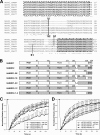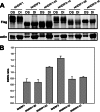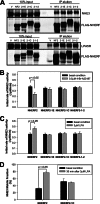NHERF2 protein mobility rate is determined by a unique C-terminal domain that is also necessary for its regulation of NHE3 protein in OK cells
- PMID: 23612977
- PMCID: PMC3675628
- DOI: 10.1074/jbc.M113.470799
NHERF2 protein mobility rate is determined by a unique C-terminal domain that is also necessary for its regulation of NHE3 protein in OK cells
Abstract
Na(+)/H(+) exchanger regulatory factor (NHERF) proteins are a family of PSD-95/Discs-large/ZO-1 (PDZ)-scaffolding proteins, three of which (NHERFs 1-3) are localized to the brush border in kidney and intestinal epithelial cells. All NHERF proteins are involved in anchoring membrane proteins that contain PDZ recognition motifs to form multiprotein signaling complexes. In contrast to their predicted immobility, NHERF1, NHERF2, and NHERF3 were all shown by fluorescence recovery after photobleaching/confocal microscopy to be surprisingly mobile in the microvilli of the renal proximal tubule OK cell line. Their diffusion coefficients, although different among the three, were all of the same magnitude as that of the transmembrane proteins, suggesting they are all anchored in the microvilli but to different extents. NHERF3 moves faster than NHERF1, and NHERF2 moves the slowest. Several chimeras and mutants of NHERF1 and NHERF2 were made to determine which part of NHERF2 confers the slower mobility rate. Surprisingly, the slower mobility rate of NHERF2 was determined by a unique C-terminal domain, which includes a nonconserved region along with the ezrin, radixin, moesin (ERM) binding domain. Also, this C-terminal domain of NHERF2 determined its greater detergent insolubility and was necessary for the formation of larger multiprotein NHERF2 complexes. In addition, this NHERF2 domain was functionally significant in NHE3 regulation, being necessary for stimulation by lysophosphatidic acid of activity and increased mobility of NHE3, as well as necessary for inhibition of NHE3 activity by calcium ionophore 4-Br-A23187. Thus, multiple functions of NHERF2 require involvement of an additional domain in this protein.
Keywords: Epithelial Cell; Exocytosis; Mobility; Scaffold Proteins; Sodium Proton Exchange; Trafficking.
Figures










Similar articles
-
NHERF2/NHERF3 protein heterodimerization and macrocomplex formation are required for the inhibition of NHE3 activity by carbachol.J Biol Chem. 2014 Jul 18;289(29):20039-53. doi: 10.1074/jbc.M114.562413. Epub 2014 May 27. J Biol Chem. 2014. PMID: 24867958 Free PMC article.
-
Lysophosphatidic acid stimulation of NHE3 exocytosis in polarized epithelial cells occurs with release from NHERF2 via ERK-PLC-PKCδ signaling.Am J Physiol Cell Physiol. 2014 Jul 1;307(1):C55-65. doi: 10.1152/ajpcell.00045.2014. Epub 2014 Apr 23. Am J Physiol Cell Physiol. 2014. PMID: 24760985 Free PMC article.
-
Both NHERF3 and NHERF2 are necessary for multiple aspects of acute regulation of NHE3 by elevated Ca2+, cGMP, and lysophosphatidic acid.Am J Physiol Gastrointest Liver Physiol. 2018 Jan 1;314(1):G81-G90. doi: 10.1152/ajpgi.00140.2017. Epub 2017 Sep 7. Am J Physiol Gastrointest Liver Physiol. 2018. PMID: 28882822 Free PMC article.
-
The epithelial brush border Na+/H+ exchanger NHE3 associates with the actin cytoskeleton by binding to ezrin directly and via PDZ domain-containing Na+/H+ exchanger regulatory factor (NHERF) proteins.Clin Exp Pharmacol Physiol. 2008 Aug;35(8):863-71. doi: 10.1111/j.1440-1681.2008.04931.x. Epub 2008 Apr 21. Clin Exp Pharmacol Physiol. 2008. PMID: 18430067 Review.
-
NHE3 regulatory complexes.J Exp Biol. 2009 Jun;212(Pt 11):1638-46. doi: 10.1242/jeb.028605. J Exp Biol. 2009. PMID: 19448074 Free PMC article. Review.
Cited by
-
The NHERF2 sequence adjacent and upstream of the ERM-binding domain affects NHERF2-ezrin binding and dexamethasone stimulated NHE3 activity.Biochem J. 2015 Aug 15;470(1):77-90. doi: 10.1042/BJ20150238. Epub 2015 Jun 16. Biochem J. 2015. PMID: 26251448 Free PMC article.
-
Traditional and emerging roles for the SLC9 Na+/H+ exchangers.Pflugers Arch. 2014 Jan;466(1):61-76. doi: 10.1007/s00424-013-1408-8. Epub 2013 Dec 12. Pflugers Arch. 2014. PMID: 24337822 Review.
-
Dynamics of ezrin and EBP50 in regulating microvilli on the apical aspect of epithelial cells.Biochem Soc Trans. 2014 Feb;42(1):189-94. doi: 10.1042/BST20130263. Biochem Soc Trans. 2014. PMID: 24450650 Free PMC article.
-
Phosphorylation of NHE3-S719 regulates NHE3 activity through the formation of multiple signaling complexes.Mol Biol Cell. 2017 Jul 1;28(13):1754-1767. doi: 10.1091/mbc.E16-12-0862. Epub 2017 May 11. Mol Biol Cell. 2017. PMID: 28495796 Free PMC article.
-
The Air-Liquid Interface Reorganizes Membrane Lipids and Enhances the Recruitment of Slc26a3 to Lipid-Rich Domains in Human Colonoid Monolayers.Int J Mol Sci. 2023 May 5;24(9):8273. doi: 10.3390/ijms24098273. Int J Mol Sci. 2023. PMID: 37175979 Free PMC article.
References
-
- Lange K. (2011) Fundamental role of microvilli in the main functions of differentiated cells: Outline of an universal regulating and signaling system at the cell periphery. J. Cell. Physiol. 226, 896–927 - PubMed
-
- Brant S. R., Yun C. H., Donowitz M., Tse C. M. (1995) Cloning, tissue distribution, and functional analysis of the human Na+/N+ exchanger isoform, NHE3. Am. J. Physiol. 269, C198–C206 - PubMed
-
- Schultheis P. J., Clarke L. L., Meneton P., Miller M. L., Soleimani M., Gawenis L. R., Riddle T. M., Duffy J. J., Doetschman T., Wang T., Giebisch G., Aronson P. S., Lorenz J. N., Shull G. E. (1998) Renal and intestinal absorptive defects in mice lacking the NHE3 Na+/H+ exchanger. Nat. Genet. 19, 282–285 - PubMed
-
- Donowitz M., Li X. (2007) Regulatory binding partners and complexes of NHE3. Physiol. Rev. 87, 825–872 - PubMed
Publication types
MeSH terms
Substances
Grants and funding
LinkOut - more resources
Full Text Sources
Other Literature Sources
Molecular Biology Databases
Research Materials
Miscellaneous

